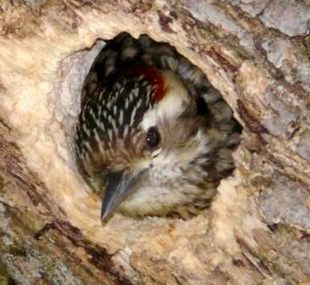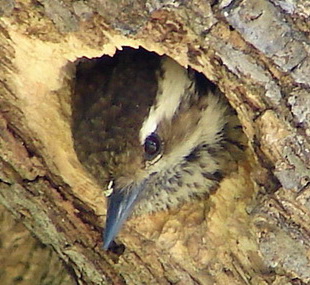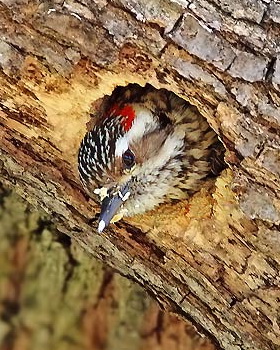Order: Piciformes - Family: Picidae
The Checkered Woodpecker is an annual resident at the reserve. It is also known as "carpinterito" for its small size compared to the other two woodpeckers at the reserve, the Green-barred Woodpecker and the Field Flicker. It is a bird easy to locate because of its habits and its call. It is 15 cm long and exhibits an attenuated sexual dimorphism. The male has a red line on the nape and a brown crown streaked white. The female lacks the red line on the nape and the crown is plain brown. To tell male from female facilitates the monitoring of the actions. A typical posture: to stick the head out of the nest and see what happens. The photos and the video belong to the same nest. They were taken between September and November 2009.
24/10 There is great activity in the nest. Parents go in with food which is quicky delivered. They provide live food: plenty of worms. The approach to the nest is gradual. They make two recognisance stops before going in. They are always on the alert. If something calls their eye, they fly away so as not to expose the location of the nest. First they perch on a nearby branch where they stay for a few seconds. With a short flight they reach a second position, always below the entrance to the nest, where they also stay for some seconds. From there they hop up the tree and dive headfirst. Done with the delivery, they resume food search. It sometimes occur that one adult arrives right after the other and has to wait outside since there is not enough room for everybody. The father cleans the nest. It removes the feces stuck in chips and gets rid of them far from it.
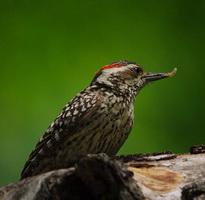 First stop at a nearby branch First stop at a nearby branch© Pablo M. Fernandez |
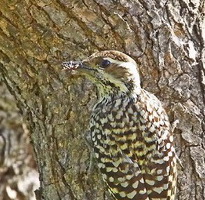 Another stop below the entrance Another stop below the entrance© José Luis Merlo |
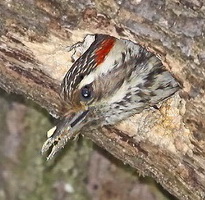 Taking rubbish away Taking rubbish away© José Luis Merlo |
6/11 The nest "sounds". The noises of chicks claiming for food are heard. The adults are extremely busy with food provisioning. They bring worms, spiders, insects, etc. Nestlings are still not seen, but evidently they are growing. As parents reach the doorway, they look for the best way in. Bigger chicks imply more cleaning to do, always done by the male.
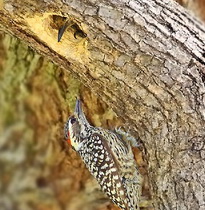 Passing each other on the way Passing each other on the way© José Luis Merlo |
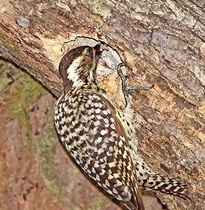 Female delivering a piece of food Female delivering a piece of food© José Luis Merlo |
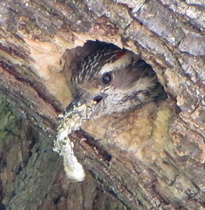 More cleaning is necessary More cleaning is necessary© Amelia Besana |
14/11 A chick looks out emitting the typical adult call. Tow cues which show the maturation of the locomotive and vocal system. Unluckily it is not possible to see the developmental stage of wings. The nestling shows a distinctive red crown. The rest of the body can not be fully appreciated, but it seems to look like the adult´s. Since it stays in the doorway food is given right there. Parents must be careful not to be caught by the desperate pecks of the young. It is not clear whether there is a second nestling. On some occasions the female gets into the nest with food. There might be another less active nestling.
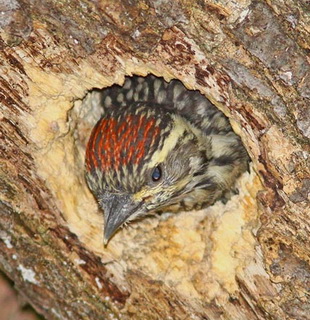 © José Luis Merlo © José Luis Merlo |
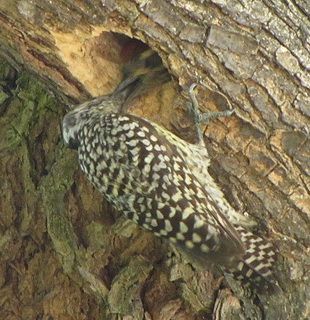 © Amelia Besana © Amelia Besana |
15/11 Only one nestling looks out. Strikingly it changes the call. While its parents are away for food, it utters the adult call. As they show up, ithe nestling changes the call into a previous weaker one. 20/11 The nest is inactive. Neither voices nor movements of the family are observed.
Video taken between September and November 2009 © Roberto Ares


